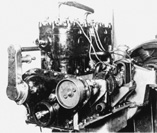Liberty truck
| Standard B "Liberty" Truck | |
|---|---|
 |
|
| Overview | |
| Manufacturer | Various |
| Production | 17,093 |
| Body and chassis | |
| Class | B 3 to 5 short tons (2.7 to 4.5 long tons; 2.7 to 4.5 t) |
| Body style | open cab, Cargo truck |
| Powertrain | |
| Engine |
Gasoline, 425 cu in (6,960 cc; 6.96 L) L-head, 4-cycle, 52 hp (39 kW), |
| Transmission | 4 speed, 4X2, |
| Dimensions | |
| Wheelbase | 160.5 in (4,077 mm) |
| Length | 261 in (6,629 mm) |
| Width | 84 in (2,134 mm) |
| Height | 75 in (1,905 mm) |
| Curb weight | 3–5 short tons (2.7–4.5 long tons; 2.7–4.5 t) |
The Standard B "Liberty" Truck was a United States Army vehicle used in World War I.
The Liberty Truck was designed by the Motor Transport section of the Quartermaster Corps in cooperation with the members of the Society of Automotive Engineers. Production of the 3–5 ton truck began in 1917, and the first models appeared ten weeks after the design was standardized. Of the almost 9,500 produced by 15 manufacturers, more than 7,500 were sent overseas. The Liberty's four-speed transmission coupled with its 52-hp engine gave the truck a top speed of about 15 miles per hour (24 km/h).
The Standard B "Liberty" Truck's powertrain utilized a gasoline powered 425 cubic-inch flat-head inline four cylinder that put out 52 horsepower, a 4 speed transmission, and a 4 X 2 drive setup.
...
Wikipedia



